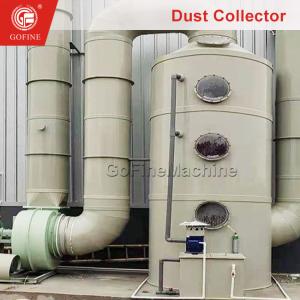

Add to Cart
Product Overview
A large amount of dust is generated during the fertilizer
production process (such as crushing, mixing, granulation, drying,
cooling, screening and packaging), which not only pollutes the
environment and harms the health of workers, but also may cause
waste of raw materials and safety hazards. Industry Cyclone
Separator Fertilizer Dust Collector System is an environmentally
friendly equipment specially used to collect and treat fertilizer
dust, which can effectively improve the cleanliness of production
and meet environmental emission standards.
Main Types of Industry Cyclone Separator Fertilizer Dust Collector
System
Based on the dust removal principle and application scenarios,
common fertilizer dust removal equipment includes:
Bag dust collector (pulse type)
Principle: Dust-containing gas passes through the filter bag, dust
is intercepted on the surface, and clean air is discharged; pulse
spray system is cleaned regularly.
Features: High filtration accuracy (≥99%), suitable for fine dust
(such as compound fertilizer, organic fertilizer powder).
Cyclone dust collector
Principle: Use centrifugal force to separate large particles of
dust, suitable for primary dust removal.
Features: Simple structure, easy maintenance, often used in
combination with other dust removal equipment.
Wet dust collector (spray tower/water film dust removal)
Principle: Capture dust through water mist, suitable for high
humidity or easy to stick dust (such as organic fertilizer
fermentation tail gas).
Features: Can simultaneously treat harmful gases such as ammonia in
exhaust gas.
Application Scenarios of Industry Cyclone Separator Fertilizer Dust
Collector System
Compound fertilizer/urea production line: handle dust in
granulation and screening.
Organic fertilizer fermentation workshop: collect dust and odor in
fermentation waste gas.
Packaging workshop: prevent fertilizer dust from overflowing and
improve working environment.
Raw material crushing/mixing section: reduce raw material loss and
improve utilization rate.
Working process
1. Bag filter (dry dust removal)
Applicable scenarios
Collection of dry dust such as compound fertilizer and urea,
especially in the granulation, screening and packaging stages.
Workflow
Air intake: Dust-containing gas enters the dust collector from the
air inlet and is evenly distributed to each filter bag through the
guide plate.
Filtration: Dust is intercepted by the surface of the filter bag
(after the initial layer of dust is formed, the filtration
efficiency is improved), and clean air is discharged from the top
through the filter bag.
Cleaning:
Pulse injection: Compressed air instantly blows back the filter bag
through the injection pipe to make the dust fall into the ash
hopper (fully automatic, suitable for continuous production).
Mechanical vibration: Cleaning the filter bag by vibrating the
motor (low cost, but low efficiency).
Dumping: The collected dust is centrally processed by a screw
conveyor or an ash discharge valve (recyclable).
Key design
Filter bag material: polyester fiber (conventional), PTFE coating
(anti-sticking, corrosion-resistant).
Cleaning control: differential pressure sensing or timed triggering
to avoid excessive cleaning that affects the life of the filter
bag.
2. Cyclone dust collector (primary dust removal)
Applicable scenarios
Pre-treatment of large dust particles (such as fertilizer raw
material crushing), often used in series with bag dust collector.
Workflow
Tangential air intake: dust-containing gas enters the cylinder at
high speed along the tangential direction, forming a rotating
airflow.
Centrifugal separation: dust is thrown to the cylinder wall due to
centrifugal force, and falls into the ash hopper after losing
kinetic energy.
Gas discharge: purified gas is discharged from the top center tube.
Limitations
The efficiency is low for fine dust <10μm (need to be combined
with high-efficiency dust collector).
3. Wet dust collector (spray/water film dust removal)
Applicable scenarios
High humidity, easy-to-bond dust (such as organic fertilizer
fermentation waste gas) or harmful gases (such as ammonia) need to
be treated at the same time.
Workflow (taking the spray tower as an example)
Spray washing: dust-containing gas enters from the bottom of the
tower and contacts with the spray liquid (water or chemical
solution) from top to bottom in countercurrent.
Dust capture: Dust is wrapped by droplets and settles to the bottom
sludge pool with the water flow.
Gas-liquid separation: The purified gas is discharged after
removing moisture through the demister.
Advantages
Water-soluble gases (such as NH₃, H₂S) can be removed
simultaneously.
No filter bag clogging problem, suitable for sticky dust.
Product Parameters
| Air processing capacity | 670-50,000 m³/h |
| Filtration air velocity | 1.2-1.5 m/min (bag type) |
| Inlet concentration | ≤1000 mg/Nm³ (partial ≤30 g/Nm³) |
| Outlet concentration | ≤30-50 mg/Nm³ |
| Dust removal efficiency | ≥99% |
| Equipment resistance | 800-1800 Pa |
Product Details
About Us
As an agricultural equipment supplier with more than ten years of
experience, Gofine Machine provides a variety of services to meet
the needs of customers. Our services include:
Provide various types of agricultural equipment, including organic fertilizer granulators, compound fertilizer granulators, inorganic fertilizer granulators, water-soluble fertilizer granulators, controlled-release fertilizer granulators, fertilizer batching machines, crushers, mixers, dryers, granule shaping machines, coating machines, granule screening machines, packaging machines and a complete set of fertilizer production lines.
We provide professional technical consultation and support to help customers choose the right equipment and processes and optimize the production process.
Provide equipment installation and commissioning services for customers to ensure the normal operation of the equipment and achieve the expected production results.
Provide operation training to help customer employees master the use and maintenance skills of the equipment and improve production efficiency.
Provide comprehensive after-sales service, including regular maintenance, troubleshooting and spare parts supply, to ensure the long-term and stable operation of the equipment.
We provide personalized equipment and production line design
solutions based on the specific needs of our customers to meet the
needs of fertilizer production of different scales and types.
Through these services, we are committed to providing customers
with high-quality fertilizer equipment and comprehensive support to
help them succeed in a highly competitive market.
